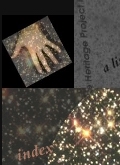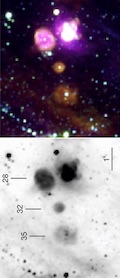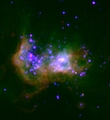



Shell formation and star formation in superbubble DEM 192
M.S. Oey & S.A. Smedley The superbubble DEM 192 in [SII], courtesy R.C. Smith. Was star formation in the OB associations, LH 51 and LH 54, triggered by the growth of the superbubble DEM 192? To examine this possibility, we investigate the stellar contents and star formation history, and model the evolution of the shell. H-R diagrams constructed from UBV photometry and spectral classifications indicate highly coeval star formation, with the entire massive star population having an age of ~< 2-3 Myr. However, LH 54 is constrained to an age of ~3 Myr by the presence of a WR star, and the IMF for LH 51 suggests a lower-mass limit implying an age of 1-2 Myr. There is no evidence of an earlier stellar population to create the superbubble, but the modeled shell kinematics are consistent with an origin due to the strongest stellar winds of LH 54. It might therefore be possible that LH 54 created the superbubble, which in turn may have triggered the creation of LH 51. Within the errors, the spatial distribution of stellar masses and IMF appear uniform within the associations. We reinvestigate the estimates for stellar wind power L_w(t), during the H-burning phase, and note that revised mass-loss rates yield a significantly different form for L_w(t), and may affect stellar evolution timescales. We also model superbubble expansion into an ambient medium with a sudden, discontinuous drop in density, and find that this can easily reproduce the anomalously high shell expansion velocities seen in many superbubbles. AJ, 116, 1263
|

